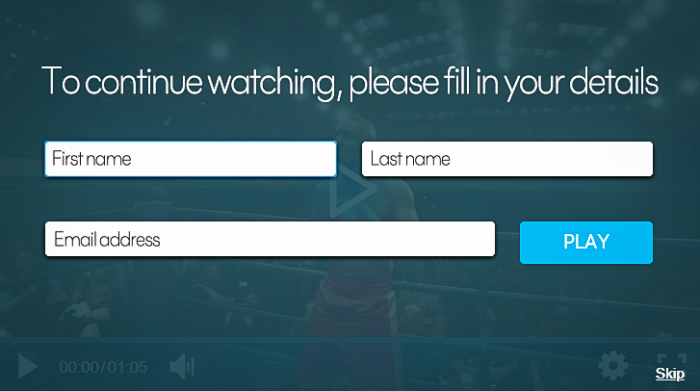During the coming decade, video will become the king of lead-generation.
YouTube is already the de-facto internet ringleader, and social networks have begun falling and rising based on the way they harness the power of video.
Today, video is in the process of taking over another area: marketing.
Consider the following:
- 79 percent of B2B consumers say a brand’s video has convinced them to buy software or an app.
- 97 percent of video marketers reported that video increased users’ understanding of a product or service, and 76 percent reported that video helped them increase sales.
- Videos attract 300 percent more traffic and help nurture leads.
We could go on, but you probably get the picture.
In this blog we’ll cover
- Video marketing core concepts and terms
- How to map videos to buyer stages
- Using social media to distribute videos
Video marketing core concepts and terms
On-video CTAs and forms
Virtually any email campaign will feature a call to action (CTA) that a contact will hopefully click on.
Forms are also marketing email and landing page staples. It’s common for B2B and B2C companies to prompt visitors to sign up for the company newsletter on their website.
Both forms and CTAs are proven lead-generating tools. Industry leaders and marketing teams the world over use them.
But why limit them to written content?
Video hosting, management, and marketing platforms make it easy to have CTAs pop up before, during, and following a video. Additionally, you’re able to prompt viewers to fill in forms that pop up immediately before or during the most exciting moment in your video.
These powerful tools provide you with actionable insights. Unlike vanity metrics, such as like-to-dislike ratio and number of total views, gaining a true understanding of individual viewer engagement will get your videos the ROI they deserve.
Brand affinity via video
Companies spend a lot of time and resources to capture their audience’s attention. When it comes to getting prospects to engage with written content, the objectives are pretty straightforward: If someone clicks on a link to a blog, a guide, or a whitepaper, you’ve succeeded.
Video, however, is a different beast.
For years, it’s been common to upload corporate videos to YouTube or Vimeo. These sites have enormous reach (especially the former), and companies instinctively flock to them to get their names out there.
However, there are drawbacks to relying on these sites.
Getting your prospect to zero in on your video while on YouTube is essentially impossible.
YouTube is designed to keep visitors on YouTube.
Whether engaged with your videos or with NFL highlights, the content someone chooses to view on YouTube is far less significant to the world’s second most popular site as long as viewers remain on the site.
Too often, relying on YouTube feels like flushing your videos down the drain.
Organizations place a premium on creating a brand-consistent environment where visitors are shielded from distracting ads and outside noise.
To perfect video marketing, you need to transform your own site into a video destination.
Companies have begun creating unique video environments. With video hosting platforms, it’s easy to set up channels where visitors can binge-watch your videos, exclusively, free of any distracting ads or videos.
Video analytics
Here’s where the magic happens.
Video marketing requires shifting beyond conventional, limited engagement metrics. As mentioned above, unleashing your videos’ true lead-generating potential means diving deeper than likes and positive comments.
Good video hosting platforms provide extensive analytical features that pertain to individual users.
When someone engages with your video, you’ll know who that person is, which device they used to view the video, and where in the world they were when they watched it.
It doesn’t end there.
Nowadays, people have notoriously short attention spans, and viewers will abandon even the most enticing videos before they finish watching them.
Features like video heatmaps allow you to see the exact point at which specific users stopped watching your video. In the event that they return to your video, you’ll be able to see the exact moment they began watching again.
The information you gain here is transformative. Beyond understanding each viewer’s behavior, you can leverage this data to optimize your videos by cutting out sections where viewers lose interest.
Good video hosting platforms provide you with information that goes far beyond likes and total views.
The key to successful video marketing: Mapping video according to stages on the buyer’s journey
Marketers should approach video marketing the same way they would any other marketing initiative. Namely, video should be targeted to specific buyer personas.
The buyers’ journey is typically divided into three stages:
- Awareness
- Consideration
- Decision
The three-tiered buyer’s journey
Video can and should guide viewers based on intent and lead maturity.
Here are a few guidelines that will help you design and create videos suitable for prospects, depending on where they are in the funnel:
Awareness stage
Consideration stage
Decision stage
This is the first step of your viewers’ journey. At this point, viewers may not even know they have a problem that needs to be addressed, let alone that you can solve it. Ideally, your videos will succeed at lighting the spark that will hopefully fuel later engagement.
Videos at this stage need to be limited to 30–90 seconds. CTAs should lead to more in-depth video content on a landing page or encourage viewers to start a free trial.
Don’t push products before creating trust with customers.
At this stage, prospects are busy researching alternatives and considering different options.
You need to showcase your solutions and build a relationship between viewers and your brand. To do this, create informative videos, explainer videos, product demos, etc.
At this stage, videos can be a little longer (2–10 min), and CTAs should lead to decision-based content.
At this stage, your prospect is ready to buy. You just need to give them a little push to get them across the finish line. Make this decision easy by providing unbiased reviews, customer testimonials, FAQs, and instructional videos.
Show your prospective customers exactly how to use your products. Show them other people, just like them, who have benefited from using your products and address any remaining doubts through Q&A videos.
Hosting webinars is a good idea at this point.
For almost 60 percent of marketers, webinars are an invaluable source of content and a critical component of their content marketing strategy.
Videos can be a bit longer here. Use CTAs to offer purchase-related offers and discounts.
How does social media fit in?
Gone are the days when you needed to worry about 30-second TV spots. Instagram, Twitter, and the emerging TikTok offer an audience scope and reach that would’ve been unfathomable just a decade ago.
Treat these platforms as promotional channels.
Facebook, Instagram, Twitter, and LinkedIn are each distinctive. The recommended video length varies depending on the platform in question. According to HubSpot, these running times are most likely to result in a good ROI:
- YouTube: 2 minutes
- Facebook: 1 minute
- Instagram: 30 seconds
- Twitter: 45 seconds
Audiences differ depending on the platform as well. Instagram, for example, caters to a younger audience, while LinkedIn is for professionals. TikTok has found its niche with Gen Zers.
Videos must appeal to each platform’s unique audience.
Instagram video posts receive over two times more comments than any other type of post.
Final word
There are very few sure things in life. Video becoming the defining element of marketing in the coming decade seems to be one of them.
To master video marketing, you have to approach video creation strategically.
Map videos to fit prospects in various stages of the buyer’s journey. And use social media platforms, especially Instagram and TikTok, as distribution channels.
If you’re looking to untap your videos’ true lead-gen potential, try a video hosting platform.






















Send Comment: